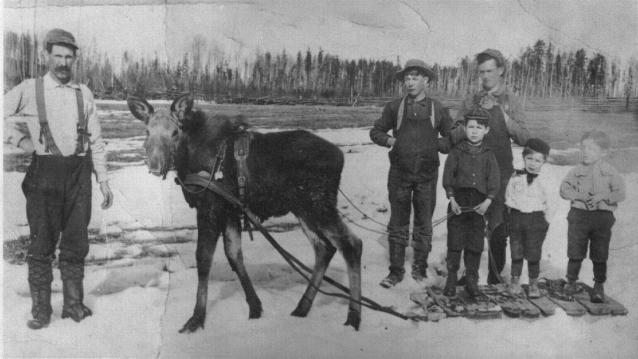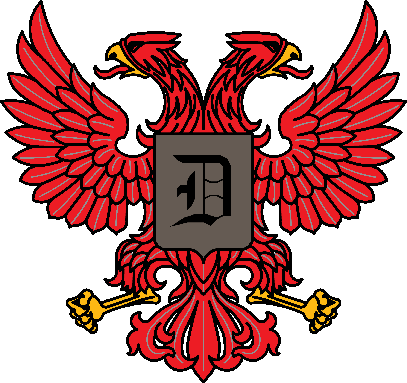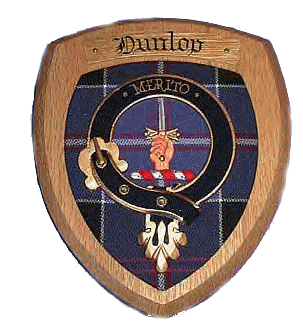

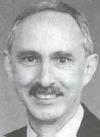
Notable Relatives
Canada
MJD from "The Black'n'Blue" 2002
Scotland/Ireland/USA/Australia/Canada/India/Caribbean/France/China
updated 2.3.09
![]()
see new bio of Tiger (submitted by Duncan McLaren)
Dr. William "Tiger"
Dunlop(1792-1848) A surgeon in the Connaught Rangers of
 Britain, William was active in the campaigns against the Americas in 1813, 1814,
and 1815 (War of 1812). William Dunlop came to Canada in 1813 as a 21 year-old
assistant surgeon with the 89th British Foot. Like other memorable war doctors,
he was faced with seemingly impossible tasks. After the battle of Chippawa,
Dunlop worked alone on 220 men from both armies because the chief surgeon had
been sent home and the chief assistant had fallen ill from fatigue. Apparently,
Dunlop carried on alone for more than two full days, barely sitting down and
stopping only to eat and change clothes.
Britain, William was active in the campaigns against the Americas in 1813, 1814,
and 1815 (War of 1812). William Dunlop came to Canada in 1813 as a 21 year-old
assistant surgeon with the 89th British Foot. Like other memorable war doctors,
he was faced with seemingly impossible tasks. After the battle of Chippawa,
Dunlop worked alone on 220 men from both armies because the chief surgeon had
been sent home and the chief assistant had fallen ill from fatigue. Apparently,
Dunlop carried on alone for more than two full days, barely sitting down and
stopping only to eat and change clothes.
The regiment was afterward transferred to Calcutta, where William contracted to
exterminate tigers from the island in the Ganges named Saugor. after having
killed an immense number of these royal game, he was called "Tiger" by the
natives.
After returning to native Scotland in Edinburgh for awhile, he embarked on a
scheme in 1826 with John Galt called "the Canada Company". In Canada he became
distinguished as a "chopper", a founder of cities along Lake Huron, a counsellor,
friend and guide to emigrants and settlers in Upper Canada, and as a humorist
and novelist. Dr Dunlop wrote a highly regarded manual in 1826 entitled
"Statistical Sketches of Upper Canada" (John Murray, London) consisting of 126
pages for the use of emigrants.
1826 with John Galt called "the Canada Company". In Canada he became
distinguished as a "chopper", a founder of cities along Lake Huron, a counsellor,
friend and guide to emigrants and settlers in Upper Canada, and as a humorist
and novelist. Dr Dunlop wrote a highly regarded manual in 1826 entitled
"Statistical Sketches of Upper Canada" (John Murray, London) consisting of 126
pages for the use of emigrants.
He was described by a colleague: "This
remarkable biped stands 6 feet 3 inches; 2 feet 8 inches across the shoulders,
his head crowned with red locks." Dr Dunlop was also a Member of the Provincial
Parliament. Gairbread Log-House, at Colborne Township (Huron District) was the
well-visited home of Dunlop and his brother, Capt Robert Dunlop. It was the
center of jovial entertainment in the wilderness, a meeting place, a refuge for
all comers. Dr Dunlop was eulogized by a friend thusly: "Farewell, noble savage!
wild as thy woods! When shall we again revel in the rich luxuriance of thy
anecdotes or shake under the titanic bray of thy laughter?! ...Though Toryism
were expelled from all the rest of the globe, it would find shelter in the log
house of Dunlop!" From 1841 until 1846 he represented Huron Riding in the
Legislative Assembly. He died in 1848.
Battle of
Lundy Lane, Niagara Falls and Dr Dunlop
![]()
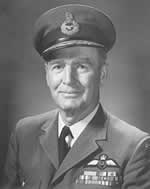 Air
Marshal Clarence Rupert “Larry” Dunlap, CBE, CD, DCL, DEng, BSc (Retired)
Air
Marshal Clarence Rupert “Larry” Dunlap, CBE, CD, DCL, DEng, BSc (Retired)
Canada’s Chief of the Air Staff, 1962-1964 Born Jan 1st 1908 - Died Oct 20th
2003 in Victoria
Clarence Rupert Dunlap was born in Sydney Mines, N.S., on Jan 1st 1908, roughly
a year before an event of major significance occurred at nearby Baddeck Bay.
There, on Feb 23rd 1909, the Silver Dart, with J.A.D. McCurdy at the controls
took off from the ice and made the first successful flight in the British
Empire, of a “heavier than air” craft. Some years later young Dunlap, aged 11,
met Alexander Graham Bell, one of the co-sponsors of this flight – so impressed
was he with Bell’s aviation achievements that it was to lead him, in future
years, in the direction of a flying career in the Royal Canadian Air Force.
Meanwhile he attended Acadia and Dalhousie Universities graduating in 1928 with
a BSc degree in electrical engineering. Joining the RCAF he earned his pilot’s
wings at Camp Borden, Ont.In 1930 Dunlap was posted to a photographic survey
detachment at Eastern Passage near Dartmouth, N.S., and there began an extensive
period of cross-Canada mapping and survey operations, utilizing Fairchild
aircraft and cameras. Dunlap was detached on several occasions on searches for
lost persons and aircraft. Many of these searches were carried out in very
difficult conditions in the most inhospitable weather season.On January 1st 1943
he was appointed to command RCAF Station Leeming, Yorkshire and to supervise the
heavy bomber units operating from that base. In May 1943 he was dispatched to
North Africa in command of 331 Wing ( 420, 424, 425 Squadrons, RCAF) for night
bomber operations against targets in Sicily and mainland Italy. His wing was the
last one to arrive during the build-up phase of the forces. Every conceivable
base had already been commandeered but, with the help and encouragement of the
overall strategic force commander, American General Jimmy Doolittle, two
airfields were built in time for operations in support of the forthcoming
landings. Under Dunlap’s stewardship the wing met with great success in the
fulfillment of many difficult missions. 331 Wing returned to England after the
fall of Sicily and the completion of its mandate in Italy. He was appointed a
Commander of the British Empire (CBE) for his part in the Italian campaign.
He was awarded the American Silver Star and the French Croix de Guerre for his
service in the European theatre of operations.
On returning to Canada in 1945 he became deputy member for air staff in which
position he was the Canadian air force representative at the Bikini Atoll atomic
tests in 1946. In 1947 he attended the National War College in Washington, D.C.
from where he returned to Ottawa to become air member for air plans at RCAF
Headquarters. Successive assignments as the commander of North West Air Command
at Edmonton, Air Defence Command at St. Hubert, Que, and the National Defence
College at Kingston, Ont, followed before appointment to the position of vice
chief of the air staff in 1954. In that assignment he played a critical role in
the build–up of the RCAF from a force of 14,000 to more than 55,000 as Canada
responded to the NATO challenge in Europe.
In 1958 he was posted to Supreme Headquarters Allied Powers Europe (SHAPE) in
the position of deputy chief of staff (operations) from which he returned to
Canada in 1962 to become, what turned out to be, the last chief of the air staff
of the Royal Canadian Air Force. In 1964 Air Marshal Dunlap was appointed deputy
commander of the North American Air Defense Command (D CinC NORAD) at Colorado
Springs, Colorado, a position from which he retired in 1967 after 39 years of
military service to his country in the uniform of the Royal Canadian Air Force.
![]()
Robert Graham Dunlop born on October 1, 1790 in Keppoch, Scotland. Robert rose to the rank of lieutenant during the Napoleonic Wars in a distinguished war career. He later captained several voyages to the East Indies and for a short time he rejoined the Royal Navy, attaining the rank of Captain before he retired in 1823. He came to Canada with his younger brother, William "Tiger" Dunlop (see above). After his arrival in Goderich, U.C. he was appointed a justice of the peace and a commissioner of the Court of Requests. He and his brother jointly owned the family farm, Gairbraid. In 1835 Captain Dunlop won a by-election to become Huron County’s first member in the House of Assembly. Dunlop joined the Orange Order in 1837. Robert Dunlop, who unlike his brother William who remained a Presbyterian joined the Anglican Church. During the 1837 Rebellion he was named colonel of the 3rd Regiment of Huron militia. After the rebellion he moved a resolution to thank the sheriff of the Home District for his actions and to award 100 acres to anyone who fought on the government side during the rebellion. He favoured improved jails, was active in the anti-slavery movement, wanted better treatment of the insane, and tried for the instituting of public libraries. Robert Dunlop represented Huron County until the close of the Upper Canadian assembly in February 1840. By that time his health had deteriorated badly and he stayed continuously at the family farm, Gairbraid, where he died in February, 1841.
![]()
Professor David Dunlop has spent most
of his career at the University of Toronto,
 Canada, teaching and doing research in physics and geophysics. He has
specialized in rock magnetism and plaeomagnetism, particularly the fundamental
aspects that flow directly from Louis Néel. He, and his wife and colleague Dr
Özden Özdemir, recently published a textbook on the subject Rock Magnetism:
Fundamentals and Frontiers. During his career, Prof. Dunlop has been fortunate
in spending several enjoyable years working in both Japan (at Tokyo and Kyoto
Universities and Tokyo Institute of Technology) and France (in CNRS Labs. in St-Maurs,
Paris and Montpellier), as well as shorter periods at CSIRO, Sydney, Australia,
the Academy of Sciences in Russia, the Johnson Space Centre, Houston, Texas, and
the Universities of Leeds, UK and Munich, Germany. Prof. Dunlop is a Fellow of
the Royal Society of Canada and of the American Geophysical Union. He served
that latter society as President of the Geomagnetism and Paleomagnetism Section
(1992 - 1994) and was President of the Canadian Geophysical Union (1985 - 1987).
Canada, teaching and doing research in physics and geophysics. He has
specialized in rock magnetism and plaeomagnetism, particularly the fundamental
aspects that flow directly from Louis Néel. He, and his wife and colleague Dr
Özden Özdemir, recently published a textbook on the subject Rock Magnetism:
Fundamentals and Frontiers. During his career, Prof. Dunlop has been fortunate
in spending several enjoyable years working in both Japan (at Tokyo and Kyoto
Universities and Tokyo Institute of Technology) and France (in CNRS Labs. in St-Maurs,
Paris and Montpellier), as well as shorter periods at CSIRO, Sydney, Australia,
the Academy of Sciences in Russia, the Johnson Space Centre, Houston, Texas, and
the Universities of Leeds, UK and Munich, Germany. Prof. Dunlop is a Fellow of
the Royal Society of Canada and of the American Geophysical Union. He served
that latter society as President of the Geomagnetism and Paleomagnetism Section
(1992 - 1994) and was President of the Canadian Geophysical Union (1985 - 1987).
![]()
Moffat Dunlap is well known throughout the Canadian horse and farm community having been a twenty year member of the show jumping team of the Canadian Equestrian Team (a Team Bronze Medal winner at the 1967 Pan-American Games and Team Gold Medal winner at the 1970 World Championships). He has served on many boards and management committees; a former director and Jumping Team Chairman of the Canadian Equestrian team over the Los Angeles Olympic Games; a past Director of the Canadian Pony Club; the Canadian Horse Council; the Canadian Horse Shows Association; the Horseman's Benevolent and Protective Association. He is an Honourary Director of the Canadian Therapeutic Riding Association and a Director, former Horse Show Chairman and a Past President of the Royal Agricultural Winter Fair. Moffat was a co-founder of an independent school in King Township, The Country Day School, with a present enrolment of 725 students. In 1995 he served on the successful election campaign team for Margaret Black, Mayor of King Township.
Moffat Dunlap is a graduate of Upper Canada College (Toronto) and the University of Western Ontario (London, Ontario). He is a member of the Advisory Council of the Equine Research Centre at the University of Guelph. Moffat Dunlap has also served on the Equine Advisory Board at both Humber and Seneca Colleges; is a member of the capital fund raising team at the Princess Margaret Hospital and the Southlake Regional Health Centre Foundation and co-chairman of the 1999 York Region Police Appreciation Committee.
![]()
